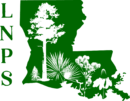Barataria Terrebonne NEP (https://invasivespecies.btnep.org/invasive-species/)
Crystal-Ornelas, R., E.J. Hudgins, R.N. Cuthbert, P.J. Haubrock, J. Fantle-Lepczyk, E. Angulo, A.M. Kramer, L. Ballesteros-Mejia, B. Leroy, B. Leung, E. Lopez-Lopez, C. Diagne, and F. Courchamp. 2021. Economic costs of biological invasions within North America. NeoBiota 67: 4485-510. (https://neobiota.pensoft.net/artile/58038/)
EDDMapS - Invasive species distribution and mapping (https://www.eddmaps.org)
Kissling, F.R. 2022. Recommendations for Control and Eradication of Exotic Invasive Terrestrial Plants, 15 p. (https://scnps.org/wp-content/uploads/2023/06/Kissling-Invasives-Eradication-Guide.pdf)
Miller, J.H., E.B. Chambliss, and N.J. Loewenstein. 2015. A field guide for the identification of Invasive Plants in Southern Forests. U.S. Forest Service Southern Research Station. 126 p. (https://www.fs.usda.gov/research/treesearch/35292)
Pimental, D., L. Lach, R. Zuniga, and D. Morrison. 2000. Environmental and economic costs of nonindigenous species in the United States. BioScience 50:53-65. (https://academic.oup.com/bioscience/article/50/1/53/231855?login=false)
Reichard, S.H. and P. White. 2001. Horticulture as a pathway of invasive plant introductions in the United States. BioScience 51: 103-113. (https://academic.oup.com/bioscience/article/51/2/103/390610)
SE-EPPC – Southeast Exotic Pest Plant Council (https://www.se-eppc.org/index.cfm)
Tu, M., C. Hurd, and J.M. Randall. 2001. Weed Control Methods Handbook: Tools & Techniques for Use in Natural Areas (https://www.invasive.org/gist/handbook.html)
“Uninvited: The Spread of Invasive Species”; A Public Broadcasting Service documentary on invasive species and their impact on local ecosystems, the economy, and human health. This WMHT production is filmed mostly in New York and highlights the invasive Spotted Lanternfly, Emerald Ash Borer, Japanese Knotweed and other species that are damaging many ecosystems of the Northeast U.S. (Uninvited Documentary)
U.S. Geological Survey Aquatic Invasives Database (https://nas.er.usgs.gov/)
U.S. Department of Agriculture National Invasive Species Information Center (https://www.invasivespeciesinfo.gov)
U.S. Environmental Protection Agency. Invasive Non-Native Species (https://www.epa.gov/watershedacademy/invasive-non-native-species)
